Mud kitchens for kids have become an increasingly popular way to encourage outdoor play and stimulate children’s imagination. These inventive play stations are designed for young children to explore, create and engage in sensory play using natural elements such as mud, water, and sand. As society becomes more aware of the importance of embracing nature and imaginative play in child development, mud kitchens have found their place in backyards, schools, and childcare centers.
Outdoor play is pivotal to the emotional, social, and physical well-being of a child. Mud kitchens, with their limitless possibilities, not only offer an engaging and interactive play platform, but also foster a sense of connection to nature, allowing kids to learn about their environment and develop essential life skills. Providing a fun and educational space, these mud kitchens are an ideal way for children to enhance sensory perception, improve fine motor skills, and interact with their peers.
The benefits of a mud kitchen for kids extend beyond physical play – they also play an important role in nurturing creativity and imagination. In a mud kitchen, children are encouraged to be inventive, collaborate with others, and explore the natural world. As a result, they develop a better understanding of their environment, learn new concepts, and discover unique ways of solving problems. Incorporating mud kitchens in children’s play areas, whether at home or in shared spaces, is an excellent way to foster their cognitive and emotional growth.
Reader's Roadmap
Benefits of Mud Kitchens
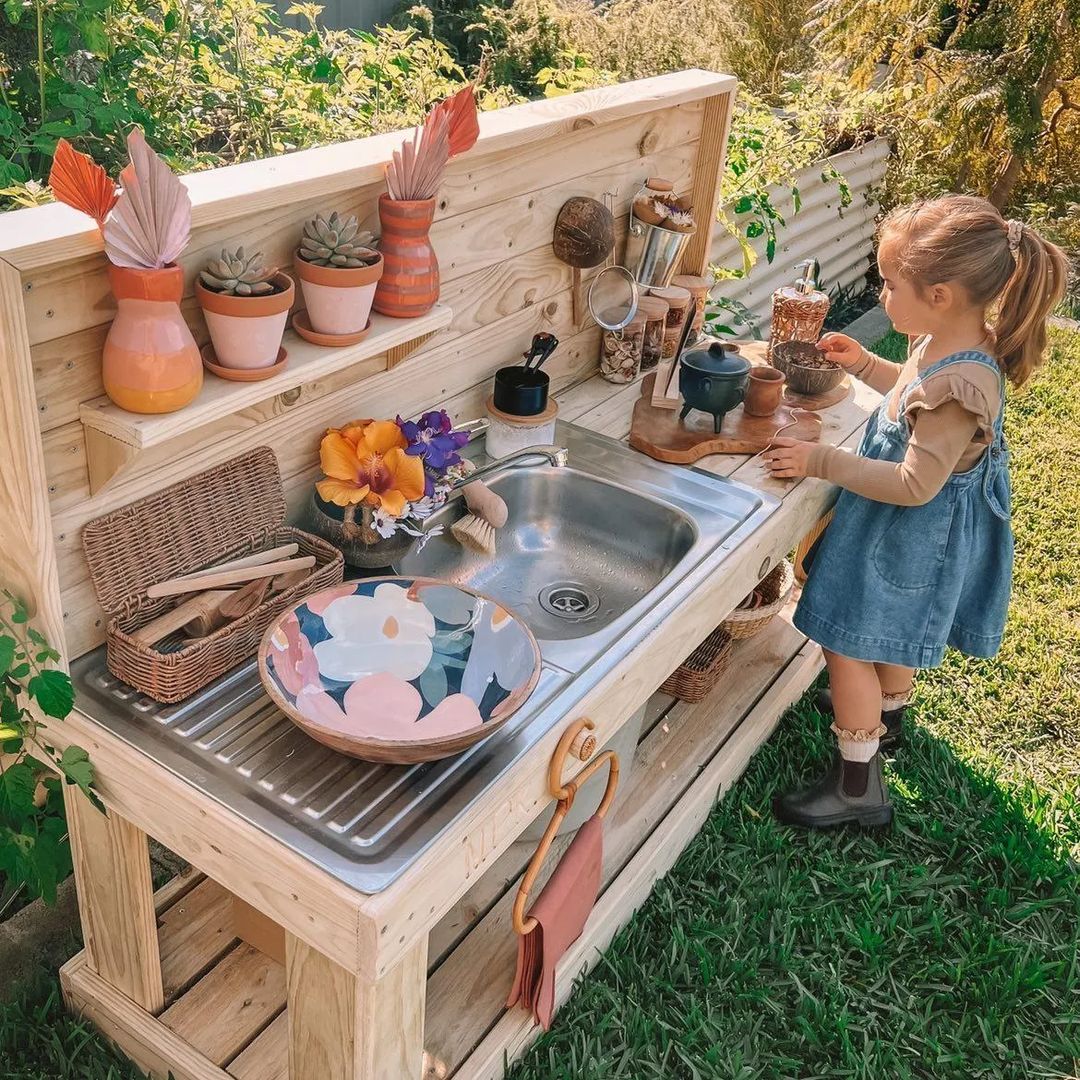
Enhancing Creativity and Imagination
Mud kitchens provide a natural and engaging environment for children to explore their creativity and imagination. The unstructured nature of mud kitchens allows for endless possibilities and encourages imaginative play. Children can pretend to cook, create potions, or engage in other pretend play scenarios. This open-endedness sparks their curiosity, enhances their creativity, and fosters cognitive development.
Developing Fine Motor Skills
Engaging in activities at a mud kitchen requires children to manipulate objects, such as sticks, spoons, and cups, and to mix and shape the mud itself. These activities help develop their fine motor skills. Such skills are essential for tasks such as handwriting, self-care, and other daily life activities. Participating in these hands-on experiences in a mud kitchen also improves their hand-eye coordination and strengthens their small muscles.
Encouraging Sensory Play
Sensory experiences are critical for a child’s development. Mud kitchens offer the perfect environment for sensory play. Children can explore different textures, smells, and even tastes as they dig, mix, and create with the mud. This type of multisensory input enhances their understanding of the world around them and supports their physical, social, and cognitive growth.
Promoting Social Skills
Mud kitchens also play a vital role in promoting social skills. Children can work together, share ideas, and take turns while exploring the mud kitchen. This interaction aids in the development of communication skills, problem-solving abilities, and cooperation. Additionally, these collaborative experiences can help build friendships and improve children’s ability to empathize with others.
| Skills Developed | Impact on Child’s Development |
|---|---|
| Creativity | Fosters cognitive growth |
| Fine Motor Skills | Supports daily life skills |
| Imaginative Play | Enhances curiosity |
| Sensory Play | Improves understanding |
| Social Skills | Enhances communication |
In summary, mud kitchens offer numerous benefits that contribute to a child’s overall development. From enhancing creativity and imagination to promoting social skills, these engaging play areas serve as a valuable learning and growth tool.
Essential Mud Kitchen Components
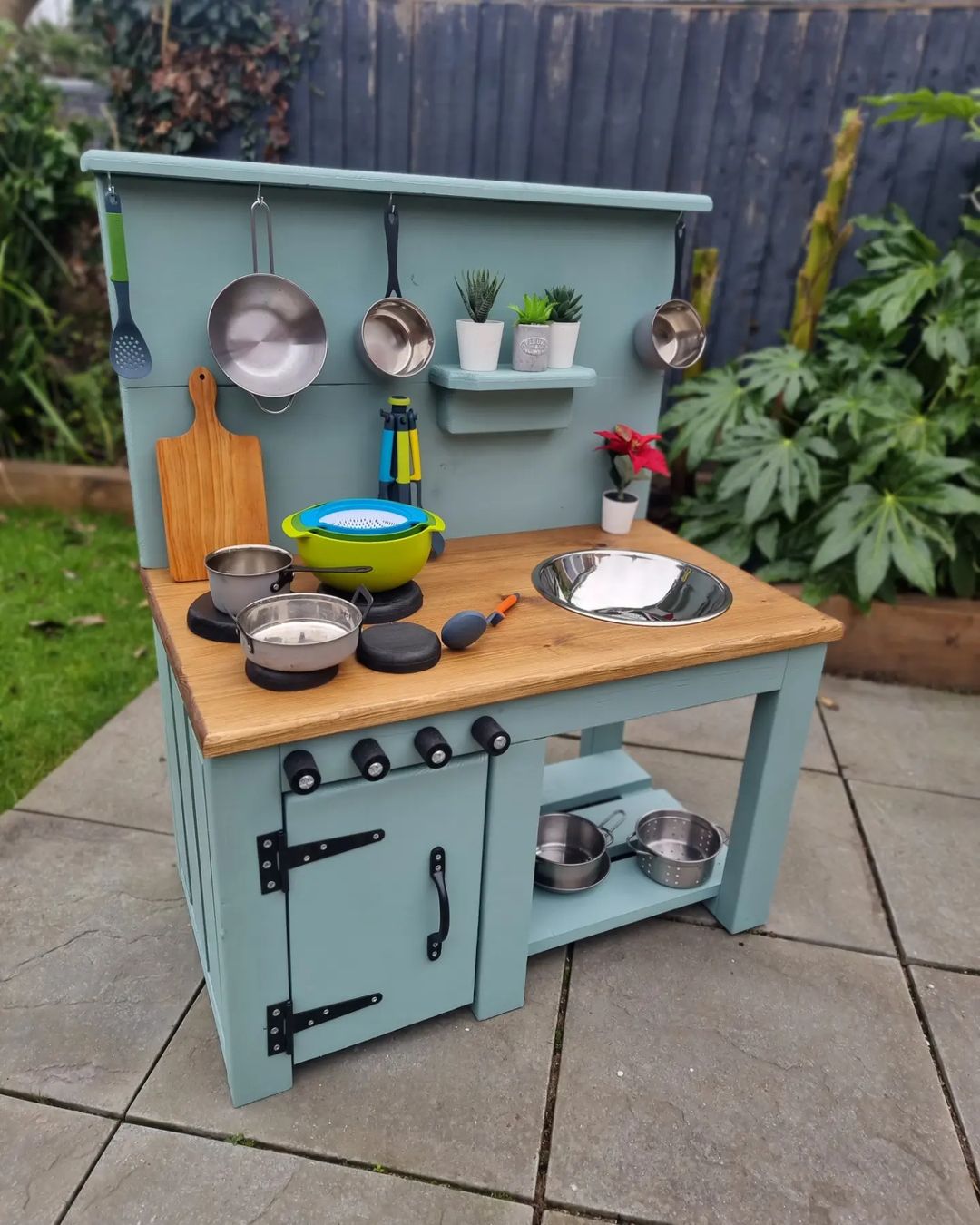
Choosing the Right Sink
A mud kitchen requires a sturdy and easy-to-clean sink for all the messy fun. It is essential to choose a sink made from durable materials, like stainless steel or plastic, as they can withstand wear and tear. Consider the size of the sink to ensure it is appropriate for your child’s height and provides enough space for multiple kids to play in the mud kitchen simultaneously.
Selecting Durable Utensils
To enhance a child’s imagination and creativity while playing with a mud kitchen, use pots and pans, as well as durable utensils such as spatulas, spoons, and whisks. It is crucial to select utensils made from sturdy materials like metal or heavy-duty plastic to withstand the wear and tear of outdoor play. Here are some essential utensils for a mud kitchen:
- Pots and pans
- Mixing bowls
- Spatulas
- Spoons
- Whisks
- Strainers
- Tongs
Incorporating Storage and Shelves
A well-organized mud kitchen needs shelves and storage spaces for all the kitchen tools and accessories. Providing storage options like shelves, hooks, and containers can help keep the mud kitchen tidy and teach children the importance of organization.
To incorporate storage and shelves, consider these options:
- Counter space: A mud kitchen should have enough counter space for children to place their utensils and tools while they play. Make sure to include an area for mixing and preparing their mud pies.
- Shelves: Install shelves on the mud kitchen to store pots, pans, and spare utensils. Shelves should be easily accessible for children and made from a durable material that can withstand outdoor conditions.
- Mud kitchen accessories: Mud kitchen accessories, such as aprons, mixing bowls, and measuring cups, can be stored in designated containers or hung on hooks within the mud kitchen play area.
Incorporating these essential mud kitchen components will make your child’s outdoor playtime engaging, fun, and organized. Remember, durability and accessibility are key factors when choosing the right sink, selecting durable utensils, and incorporating storage and shelves into your mud kitchen design.
Designing Your Mud Kitchen
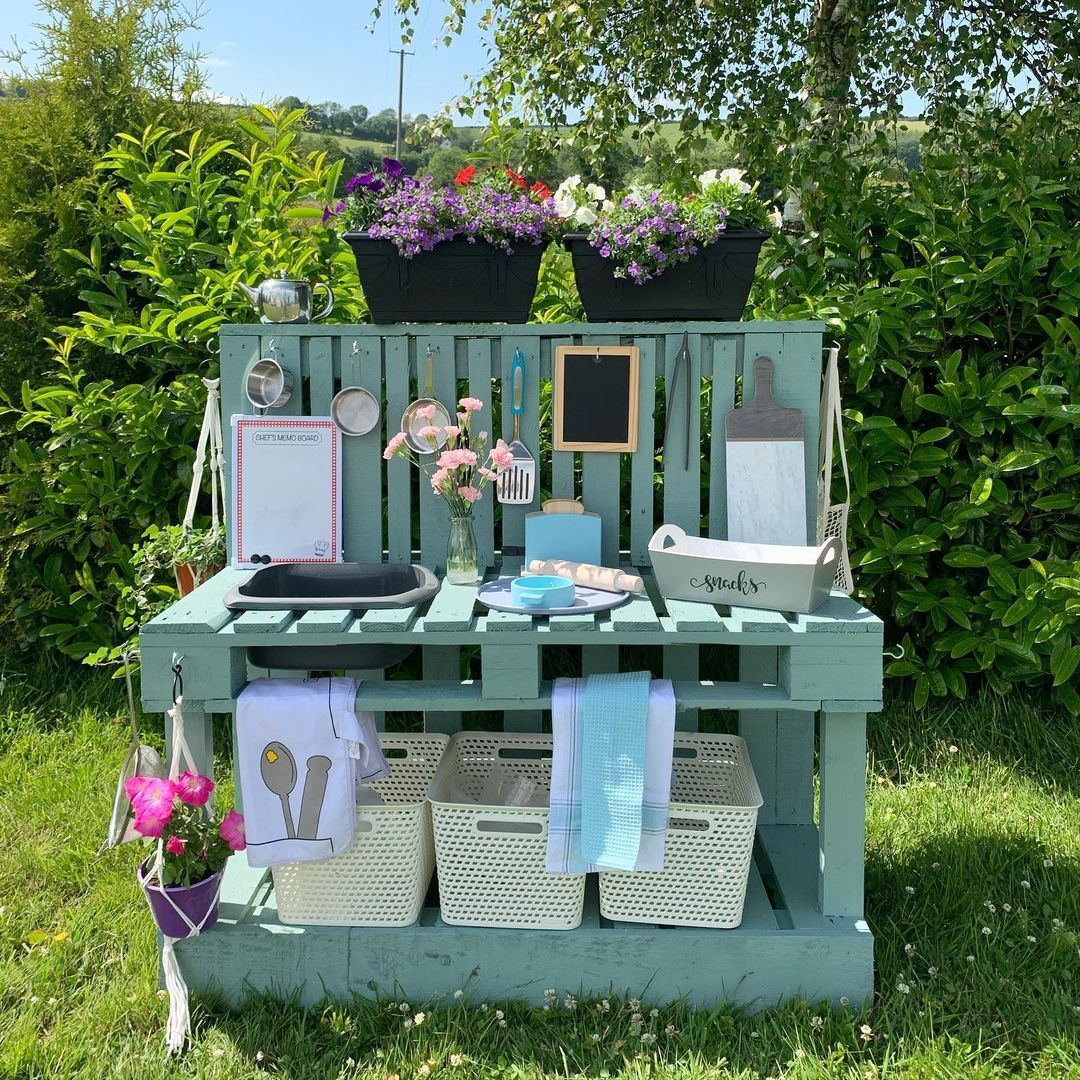
DIY Mud Kitchen Plans and Blueprints
Designing a DIY mud kitchen for your kids can be an exciting process. A great starting point involves finding suitable plans and blueprints to bring your vision to life. Sourcing inspiration from existing mud kitchen designs ensures an efficient, well-organized project. Numerous resources offer free and purchasable plans tailored for different skill levels, such as websites, books, and even social media.
| Plans & Blueprints Sources | Type |
|---|---|
| Books | Free |
| Websites (i.e., Pinterest) | Free |
| Mud Kitchen Companies | Premium |
Remember, flexibility is crucial when working with plans and blueprints, as customization adds a personal touch to your child’s mud kitchen.
Optimizing the Layout for Play
As you create your DIY mud kitchen, considering the layout for play is vital. Ensure elements such as work surfaces, shelves, and washing stations are at an appropriate height for your children. To optimize the layout for play, consider the following aspects:
- Accessibility: Make sure every feature is easy for children to reach, whether standing or sitting.
- Storage: Include space for storing tools, such as mixing bowls, spoons, and measuring cups.
- Seating: Add stools or chairs, so children can sit while playing.
Bonus Tip: Encourage creativity by incorporating a chalkboard or whiteboard for children to write recipes, draw, and create.
Selecting Materials and Tools
Choosing the right materials and tools for your mud kitchen is essential. You can use widely available materials such as pallets and scrap wood for your project. They are cost-effective and environmentally friendly options. Craigslist and Freecycle are excellent resources to find free or inexpensive wood. When selecting tools, ensure they’re safe and appropriate for young children.
Before starting your DIY mud kitchen, gather the following materials and tools:
- Building Supplies: pallets, scrap wood, screws, hinges, etc.
- A Work Surface: an old countertop, plywood, or tile can form an easy-to-clean area to prepare “mud meals.”
- Sink & Faucets: use repurposed materials, such as plastic bins or buckets, as makeshift sinks and add a faucet for realism.
- Utensils & Accessories: stock your mud kitchen with kid-friendly tools like plastic bowls, spoons, sieves, and funnels.
Make sure to use sturdy, weatherproof materials to build a durable and sustainable mud kitchen. Remember, safety comes first – it’s crucial to avoid sharp edges or hazardous materials that could cause harm.
Building a Mud Kitchen
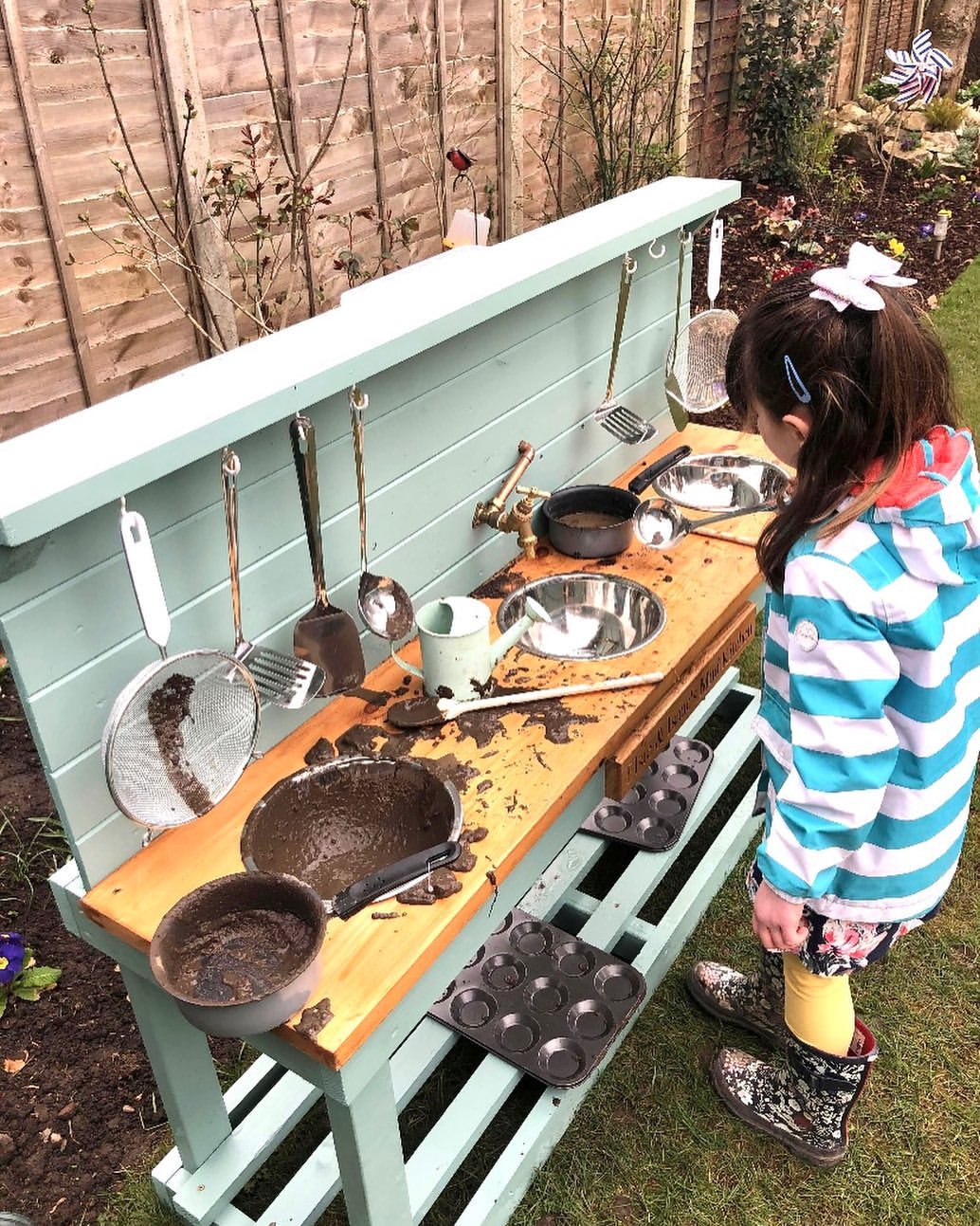
Constructing Mud Kitchen Frames
To build a durable mud kitchen, start by constructing a sturdy frame. Use materials such as wood or PVC pipes that can withstand outdoor conditions. Assemble the frame using a combination of screws, brackets, and corner braces to ensure stability. Make sure to measure and cut the materials accurately to avoid any discrepancies in assembling the framework.
Here is a brief list of materials you might need:
- Wood or PVC pipes
- Screws
- Brackets
- Corner braces
- Measuring tape
- Saw
Installing a Functional Sink
An essential component of a mud kitchen is a functional sink. To install a sink, you’ll need a large plastic bin or container as a basin, a faucet, and a drain. For the faucet, consider using a garden hose spigot or a simple PVC tap connected to an outdoor water source. For the drain, drill a hole at the bottom of the basin and attach a pipe or tubing to guide the water away from the kitchen area.
| Step | Process |
|---|---|
| 1 | Choose a large plastic bin or container |
| 2 | Attach a faucet or garden hose spigot |
| 3 | Drill a hole at the bottom of the basin for drainage |
| 4 | Connect a pipe or tubing to guide the water away |
Adding Accessories and Appliances
To complete the mud kitchen, add various accessories and appliances that promote creativity and imaginative play. For instance, you can include an oven made from wooden boxes or plastic storage containers with painted knobs to control temperature. Add shelves or hooks to hang pots, pans, and utensils, and small compartments for storing mud pies and other creations. Feel free to personalize the mud kitchen with paint and decorations, ensuring all materials used are weather-resistant.
Here are some suggested accessories:
Appliances:
- Oven
- Stove
Storage:
- Shelves
- Hooks
Utensils:
- Pots and pans
- Spatulas and spoons
- Measuring cups
Building a mud kitchen encourages outdoor play and creativity amongst children while providing a learning platform to enhance their cognitive and motor skills. With the right construction techniques, a functional sink, and suitable accessories, you can create a delightful mud kitchen that will be enjoyed for years to come.
Mud Kitchen Activities and Play Ideas
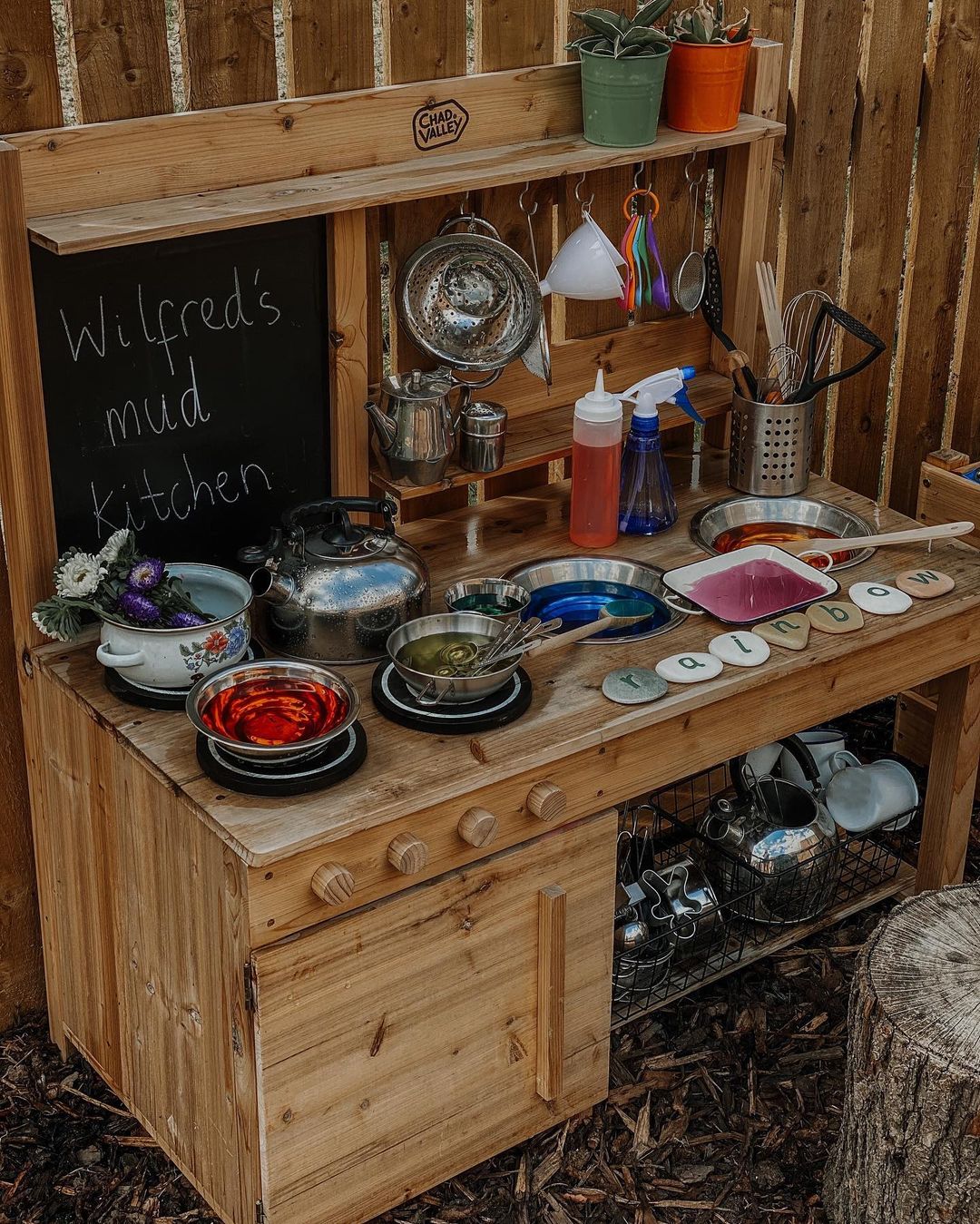
Creating Mud Pies and Nature Soups
Mud kitchens provide endless opportunities for kids to engage in messy play and independent play. One popular activity is creating mud pies and nature soups. Using a combination of mud, water, and various natural materials like leaves, sticks, and rocks, children can develop skills in problem solving by mixing different elements together. Encourage kids to experiment with:
- Different ratios of mud and water, to create varied textures
- Adding various natural materials to their creations
- Using kitchen utensils to mix and pour ingredients
Imaginative Cooking Scenarios
Mud kitchens allow children to participate in imaginative play by creating their own cooking scenarios. Provide a variety of tools and utensils, like pots, pans, spoons, and bowls, to stimulate creativity. Here are some ideas for imaginative cooking scenarios:
- Outdoor restaurant: Encourage kids to pretend they’re chefs in an outdoor restaurant, creating and serving nature-based dishes to their friends or family members.
- Magic potions: Transform the mud kitchen into a laboratory where kids can concoct magical potions and experiment with different ingredients.
- Bake-off competition: Host a friendly competition among the kids, challenging them to create their most imaginative mud pie or nature soup recipe.
Learning Through Messy Play
The skills acquired in mud kitchens extend beyond imaginative play and problem solving. As children engage in messy play, they develop a variety of abilities and acquire valuable sensory experiences:
| Skills Developed | Examples |
|---|---|
| Fine motor skills | Mixing, stirring, and pouring ingredients |
| Sensory exploration | Feeling various textures and temperatures of materials |
| Social interaction | Collaborating with peers in shared scenarios |
| Language development | Discussing and describing their creations |
Remember to include opportunities for both independent play and group activities, allowing children to grow and learn through different modes of interaction in the mud kitchen.
Maintaining and Cleaning Your Mud Kitchen
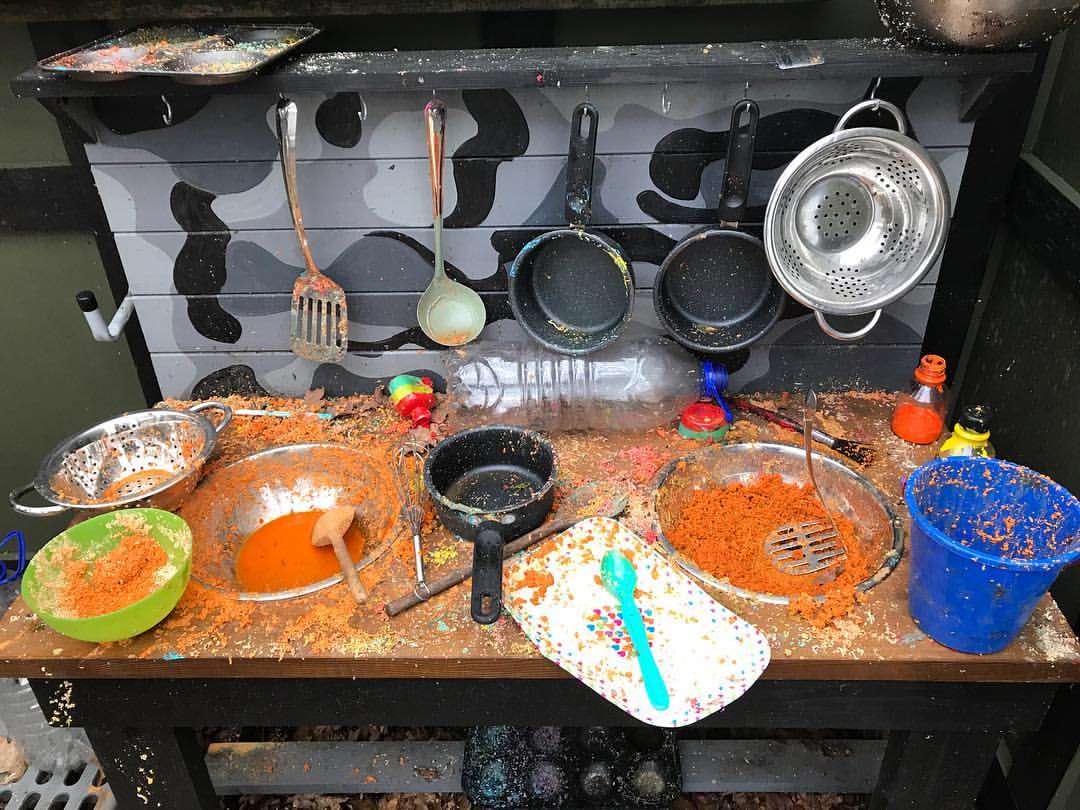
Daily and Seasonal Maintenance Tips
Regular maintenance is essential to keep your outdoor mud kitchen in excellent condition for your little ones. Here are a few tips for daily and seasonal upkeep:
- Daily: After playtime, ensure that all the mud play tools and accessories are cleaned and put away. Wipe down the countertops and check for any potential damage, such as loose screws or broken parts.
- Weekly: Inspect the area surrounding the mud kitchen for any hazards, such as sharp objects or tripping hazards. Keep the mud kitchen area clean and clear of debris.
- Seasonally: At the beginning and end of each season, perform a thorough inspection of the mud kitchen structure and its components. Look for signs of wear and tear, and repair or replace any damaged parts. Apply a fresh coat of weather-resistant paint or treatment to protect wooden surfaces from the elements.
Effective Cleaning Techniques
A clean mud kitchen helps prevent the buildup of dirt and bacteria. To ensure a sanitary and enjoyable play space for your children, follow these effective cleaning techniques:
- Basic Cleaning: Use a hose or a bucket of water to rinse away mud and dirt from all surfaces. For stubborn stains, a soft brush and mild soap can be used. Rinse thoroughly and allow the mud kitchen to dry completely.
- Disinfecting: Periodically disinfect countertops and other surfaces that come into contact with children’s hands and toys. A simple solution of 1 part bleach to 10 parts water can be used. Apply the mixture with a spray bottle, let it sit for a few minutes, then rinse off thoroughly and allow the surfaces to dry.
| Surface | Cleaning Frequency |
|---|---|
| Countertops | Daily |
| Mud play tools | After each use |
| Play area floor | Weekly |
By following these maintenance and cleaning routines, your outdoor mud kitchen will remain a safe and fun environment for children to engage in creative and sensory play.
Enhancements and Customizations
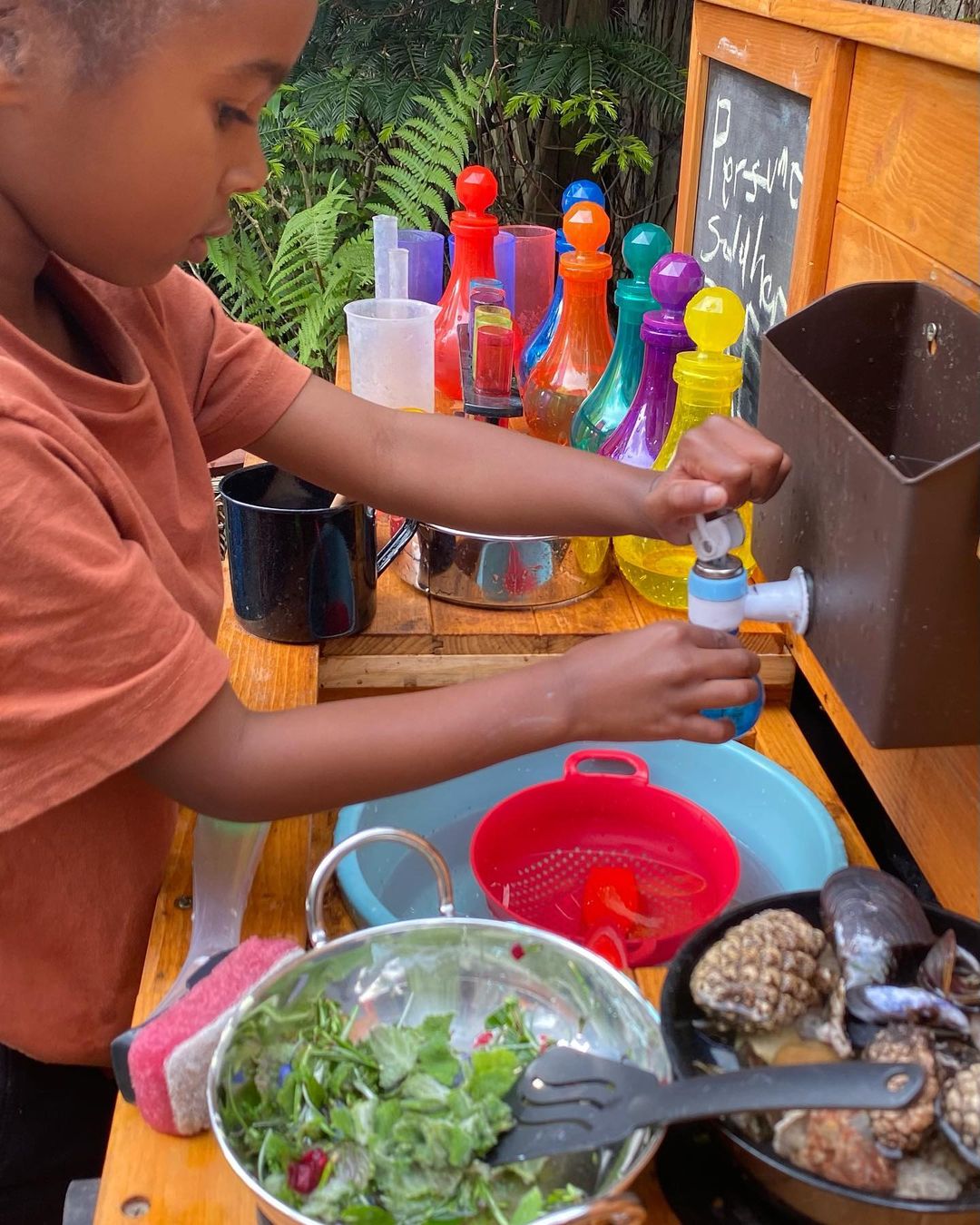
Expanding Play Possibilities with Accessories
Enhancing a mud kitchen can be as simple or as elaborate as you desire. By incorporating various mud kitchen accessories, play possibilities can be expanded to spark creativity and imagination. Some examples include:
- Utensils: spoons, forks, knives, whisks, ladles, and measuring cups
- Cookware: pots, pans, plates, bowls, trays, and muffin tins
- Containers: spice jars, shakers, and bottles to store mud “ingredients”
- Decorations: placemats, tablecloths, bunting, and small potted plants
These items can be found at home or purchased inexpensively at thrift stores.
Themed Mud Kitchen Ideas
To further enhance a child’s experience, consider incorporating a theme into the design. Some popular mud kitchen ideas include:
- Nature-Based: Embrace the outdoors by adding elements like pinecones, leaves, sticks, and shells for decoration and play.
- Cafe: Design the kitchen as a small cafe with a menu board, apron, chef’s hat, and marker for customers to place orders.
- Fantasy: Encourage imaginative play by integrating elements like flags, faux flowers, or even a small fairy garden near the kitchen.
These themes can be adapted to suit particular interests and to provide children with engaging, creative play opportunities.
Upcycling for Unique Designs
Creating a unique mud kitchen design can be achieved by upcycling materials like pallets and tires. These materials can be found at little to no cost and transformed into functional yet versatile play spaces. For instance:
- Pallets: Dismantle pallets to create a sturdy frame or base with a countertop. Pallet wood can also be used for shelving, storage, or a chalkboard menu.
- Tires: Repurpose old tires as colorful storage solutions for utensils and containers or as playful seating around the kitchen area.
Upcycling not only creates one-of-a-kind kitchen designs but also encourages environmental responsibility by repurposing materials that might otherwise be discarded.



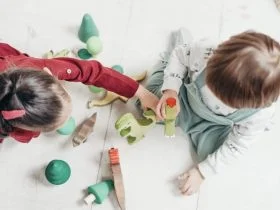


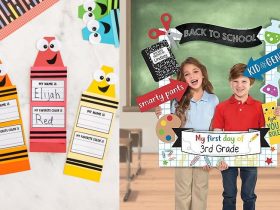
Leave a Reply
View Comments